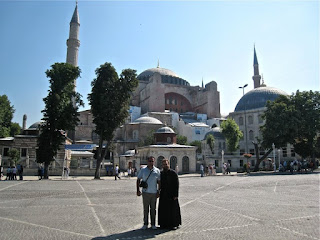We started our third and final day at Hagia Sophia. Across a beautiful and lush green park lies the Islamic counterpoint to Hagia Sophia, the Blue Mosque, pictured above in the photo taken from the entrance to Hagia Sophia.
Paris and I at Hagia Sophia.
Inside Hagia Sophia. In the center of the photo is the sanctuary of Hagia Sophia, but now most of the elements you see in this photo are from the 500 years it was used as a mosque. On the left is the sultan's loge, from which the sultan could participate in the mosque services with some privacy and, most importantly, protection from assassins. Apparently, the mosque was considered a vulnerable target, since Muslims cannot interrupt their prayer once they have started.
In about the center of the church, a bit off toward the south (i.e., about where the bishop's throne now stands in most Orthodox churches), stands the omphalion, the place where Byzantine emperors were crowned and where they sat on their thrones and followed the services.
A photo from the upper floor. Fr. Panayiotis and one of the guys who came with us, Andreas, are in the lower left hand corner.
A set of windows on the upper floor. On the outside, a crew sits on scaffolding cleaning each pane of glass.
Fr. Panayiotis and Paris admiring one of the incredible mosaics on the upper floor. The one above:
"The Deësis ('Δέησις' in Greek, meaning Entreaty) mosaic probably dates from 1261. It was commissioned to mark the end of 57 years of Roman Catholic use and the return to the Orthodox faith. It is the third panel situated in the imperial enclosure of the upper galleries. It is widely considered the finest in Hagia Sophia, because of the softness of the features, the humane expressions and the tones of the mosaic. The style is close to that of the Italian painters of the late 13th or early 14th century, such as Duccio. In this panel the Virgin Mary and John the Baptist (Ioannes Prodromos), both shown in three-quarters profile, are imploring the intercession of Christ Pantocrator for humanity on Judgment Day. The bottom part of this mosaic is badly deteriorated, probably due to rain since the mosaic is next to the windows. This mosaic is considered as the beginning of the Renaissance in Byzantine pictorial art."
Above is the beautiful Empress Zoe mosaics:
"The Empress Zoe mosaics on the eastern wall of the southern gallery date from the 11th century. Christ Pantocrator, clad in the dark blue robe (as always the custom in Byzantine art), is seated in the middle against a golden background, giving His blessing with the right hand and holding the Bible in His left hand. On either side of His head are the monograms IC and XC, meaning Iēsous Khristos. He is flanked by Constantine IX Monomachus and Empress Zoe, both in ceremonial costumes. He is offering a purse, as symbol of the donation he made to the church, while she is holding a scroll, symbol of the donations she made. The inscription over the head of the emperor says : "Constantine, pious emperor in Christ the God, king of the Romans, Monomachus". The inscription over the head of the empress reads as follows : "Zoë, the very pious Augusta". The previous heads have been scraped off and replaced by the three present ones. Perhaps the earlier mosaic showed her first husbandRomanus III Argyrus or her adopted son Michael IV. Another theory is that these mosaics were made for an earlier emperor and empress, with their heads changed into the present ones."
You can see, especially where the (long) name of the Emperor Constantine is written in the upper left hand corner that originally there was probably a much shorter name there, hence the name is rather squeezed.
Here is some 9th century Runic graffiti carved into the soft marble of the upper floor by the Viking (i.e. Scandanavian) bodyguards of the Byzantine emperor.
Fr. Panayiotis looking down on the narthex of Hagia Sophia from the upper floor. The green discs you see in the upper right of the photo are large wooden discs with (I believe) something written from the Koran. Frankly, the cheapness of the wood construction really clashes with the rest of the magnificent building and has baffled me since my first visit here four years ago.
For more photos from our third and final day, click here.











No comments:
Post a Comment